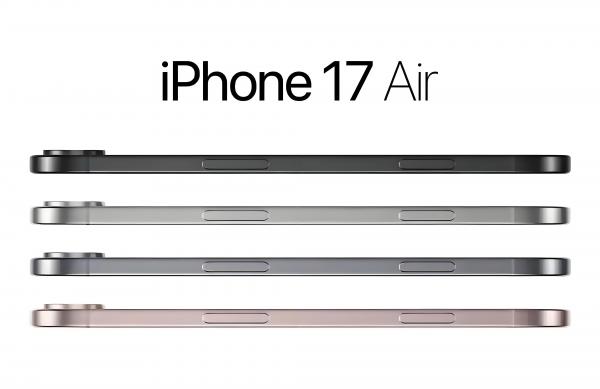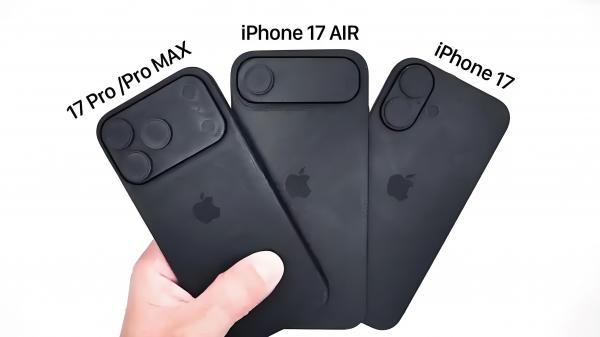Exclusive Exposure: iPhone 17 Air Imminent – Get a Sneak Peek Now!
![]() 04/24 2025
04/24 2025
![]() 410
410
Recent leaks about the iPhone 17 have been abundant, revealing a device that evolves daily, from its appearance to its specifications, and across the Pro to the Air models. The hashtag #hands-on with the new iPhone 17 series models# has even soared to the top of Weibo's trending list.
According to the latest buzz, Apple is set to unveil the iPhone 17 Air this year, a new variant poised to replace the existing Plus series.

The iPhone 17 Air's lightweight design stands out as its primary highlight. Tipsters closely following Apple products suggest that the phone's thinnest point could measure just 5.5mm, slimmer than the 7.8mm thinnest point of the iPhone 16 and iPhone 16 Plus. This is anticipated to make it Apple's thinnest phone ever, potentially 1mm thinner than the Samsung S25 Edge, undoubtedly captivating the attention of many consumers.
However, the lightweight design has sparked concerns about durability. The iPhone 6 Plus, for instance, faced the "bendgate" issue due to its excessively thin aluminum alloy body, causing it to bend when kept in pockets.
Fortunately, the iPhone 17 Air is expected to feature titanium-aluminum alloy, a material known for its enhanced strength, potentially addressing this concern.
Moreover, the iPhone 17 Air's rear camera design introduces a bold innovation with Apple's new horizontal bar-shaped camera setup, resembling a runway and sharing design cues with the Google Pixel 9 series. This not only enhances the phone's visual appeal but also underscores Apple's distinctive approach to product design.
No wonder many netizens have remarked that the iPhone 17 Air bears a resemblance to the Pixel. Judging from the available renders, the camera layout does indeed mirror that of the Pixel, suggesting a "tacit understanding" between these two American tech giants.
Another noteworthy aspect is that the iPhone 17 Air does not compromise on camera control buttons despite its lightweight design. Additionally, the speaker and microphone grilles at the bottom differ from previous iPhones, featuring smaller openings, hinting at a possible redesign of the speaker layout.
In the display department, the iPhone 17 Air sees a significant upgrade, introducing high refresh rate screen technology to non-Pro models for the first time, significantly enhancing the daily user experience.
Performance-wise, the iPhone 17 Air will undoubtedly be powered by Apple's latest AI intelligent technology and a formidable chipset. While the specific model remains undisclosed, rumors point towards the A19 chipset or an even higher-tier A19 Pro chipset, promising a smoother and more intelligent user experience.
It's well-established that the entire iPhone 17 series will employ the A19 chip, fabricated using TSMC's 3nm++ process, assuring impressive performance.
A feature that truly promises freshness for users is the rumored self-designed Bluetooth and Wi-Fi combination chip, poised to enhance communication efficiency. Notably, this chip is distinct from the Apple-designed baseband C1 introduced with the iPhone 16e and will not feature in the iPhone 17 series.
Furthermore, the Pro series will introduce a VC vapor chamber and graphene cooling system for the first time, potentially alleviating overheating during gaming.
However, this ultra-thin design comes with a notable drawback – a battery capacity of just over 3000mAh. Coupled with the large screen and high refresh rate, battery life could emerge as a significant concern.
With the iPhone 17 Air's launch, Apple may further propel the adoption of eSIM technology. Given the phone's thickness constraints, a physical SIM card slot may be absent. While this poses no issue in regions supporting eSIM, users reliant on physical SIM cards may need time to adapt. Nevertheless, this reflects Apple's commitment to technological innovation and enhanced user experience.
Regarding pricing, foreign media have made predictions. The standard version is expected to start at 5999 yuan, the Pro series at 7999 yuan, and the top-end Pro Max could reach 9999 yuan. Notably, the Air model is anticipated to have a starting price of just 5499 yuan.
Currently, the national subsidy policy extends until the end of the year. If the new phone qualifies for this subsidy, its price becomes even more compelling.

Lastly, Apple journalist Mark Gurman has revealed that Apple is undergoing its most radical system design overhaul in history, with iOS 19 set to be the most significant upgrade since iOS 7. Drawing inspiration from visionOS's visual language, iOS 19 aims to create a seamless operating experience across devices.
Gurman notes that iOS 19 will adopt the semi-transparent elements of the Vision Pro system, redesign window styles, and introduce new window and button types.
Apple plans to officially unveil iOS 19 at WWDC, with the new iPhone 17 series shipping pre-installed with this groundbreaking operating system in September.
Gurman also stated that by 2026 or 2027, the Dynamic Island on Pro models will shrink, as Apple intends to move more components under the screen. This indicates that an under-screen Face ID solution could debut as early as the iPhone 18 Pro series, leaving only a single front camera visible, akin to the single punch-hole design of Android phones like the Google Pixel 9 and Samsung Galaxy S25.
Previously, patents related to under-screen Face ID have been disclosed multiple times. For Apple to achieve under-screen 3D face recognition, it must first address the challenge of improving infrared light transmittance. While infrared light can pass through displays, its transmittance is poor. Forcing it under the panel would slow down the face recognition process and compromise security.
The latest patents reveal that Apple deletes certain subpixels to allow infrared light to penetrate the cover plate, enabling under-screen 3D face recognition. These missing subpixels are imperceptible to the naked eye, and Apple will optimize them to ensure consistent display performance.

Considering the current information, the iPhone 17 series introduces significant changes compared to its predecessor. Notably, the product lineup has been adjusted, with the Plus version being phased out and the ultra-thin Air model being introduced. This marks Apple's second product line adjustment in four years, following the replacement of the small-screen mini model with the larger Plus model. In fact, several manufacturers, including Samsung, are also focusing on ultra-thin and lightweight models, though none have been officially launched yet, making it premature to assess their market potential and user experience.
So, if you have any thoughts on the latest revelations about the iPhone 17 Air, feel free to share them in the comments section and join the discussion with Mingmei Wuxian!








